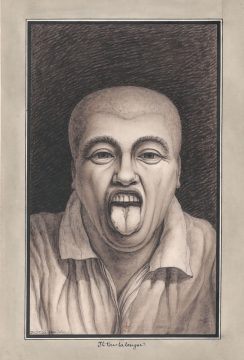Meredith Martin at Artforum:
 Like other early-modern architects, Lequeu’s drawings explore analogies between bodies and buildings and the erotic, multisensory dimensions of architectural design. In his annotations, he often describes in compulsive detail not only how buildings look but also how they feel, smell, and even taste—which admittedly sounds weird until you read Nicolas Le Camus de Mézières’s Le génie de l’architecture, ou L’analogie de cet art avec nos sensations (The Genius of Architecture; or, The Analogy of That Art with Our Sensations, 1780), a building treatise informed by eighteenth-century sensationalist and materialist philosophy, or Jean-François de Bastide’s La petite maison (The Little House, 1758). The latter text, a libertine novella centering on a marquis who bets a young ingénue that he can seduce her by taking her on a tour of his “pleasure house” (maison de plaisance) outside of Paris, contains descriptions of scented walls and furnishings, a mechanical dining table that drops through a trapdoor, and a mirrored boudoir disguised as a trompe l’oeil forest that readily call to mind the drawings of Lequeu.
Like other early-modern architects, Lequeu’s drawings explore analogies between bodies and buildings and the erotic, multisensory dimensions of architectural design. In his annotations, he often describes in compulsive detail not only how buildings look but also how they feel, smell, and even taste—which admittedly sounds weird until you read Nicolas Le Camus de Mézières’s Le génie de l’architecture, ou L’analogie de cet art avec nos sensations (The Genius of Architecture; or, The Analogy of That Art with Our Sensations, 1780), a building treatise informed by eighteenth-century sensationalist and materialist philosophy, or Jean-François de Bastide’s La petite maison (The Little House, 1758). The latter text, a libertine novella centering on a marquis who bets a young ingénue that he can seduce her by taking her on a tour of his “pleasure house” (maison de plaisance) outside of Paris, contains descriptions of scented walls and furnishings, a mechanical dining table that drops through a trapdoor, and a mirrored boudoir disguised as a trompe l’oeil forest that readily call to mind the drawings of Lequeu.
more here.
